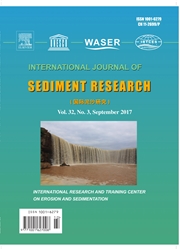

 中文摘要:
中文摘要:
这份报纸从 1950 ~ 2003 用测量数据在更低的黄河学习在满满的分泌物,侧面的生气的节变化和到来的流动和沉积状况之间的关系。自从 1950,满满的分泌物显然减少了,到流动深度的隧道宽度的比率增加了。批评年度平均到来的沉积系数(定义为沉积集中的比率排出) 并且分别地,在 Huayuankou 车站的分泌物为从 Huayuankou 发生在活动范围到 Lijin 的没有积聚的免职是约 0.012 和 1,850 m3 s1。在这个基础上,一个数学模型被用来在不久的将来在可能的到来的流动和沉积条件下面在更低的黄河和它的相应满满的分泌物学习主要隧道的规模。影响主要隧道的规模的主要因素被分析,并且测量塑造并且坚持说一条中型的隧道被讨论。结果显示出在塑造主要隧道上免除 Xiaolangdi 水库的各种各样的水和沉积联合的效果并且建议在最近的到来的流动和沉积条件下面,与满满的分泌物塑造并且维持一条中型的隧道是可能的近似 4,000 m3 s1。
 英文摘要:
英文摘要:
This paper studies relations between bankfull discharge, lateral cross section variation and the incoming flow and sediment condition in the Lower Yellow River using measured data from 1950 to 2003. Since 1950 the bankfull discharge has obviously decreased and the ratio of channel width to flow depth has increased. The critical annual average incoming sediment coefficient (defined as the ratio of sediment concentration to discharge) and discharge at the Huayuankou station are approximately 0.012 and 1,850 m3 s"l, respectively, for no accumulative deposition occurring in the reach from Huayuankou to Lijin. On this basis, a mathematical model is used to study the scale of the main channel in the Lower Yellow River and its corresponding bankfull discharge under possible incoming flow and sediment conditions in the near future. The main factors influencing the scale of the main channel are analyzed, and measures to shape and maintain a medium-sized channel are discussed. The results show the effect of various water and sediment combinations released from the Xiaolangdi Reservoir on the shaping of the main channel and suggest that under recent incoming flow and sediment conditions, it is possible to shape and maintain a medium-sized channel with a bankfull discharge of approximate 4,000 m3 s-1.
 同期刊论文项目
同期刊论文项目
 同项目期刊论文
同项目期刊论文
 Analyzing the 2007 drought of Poyang Lake watershed with MODIS-derived normalized difference water d
Analyzing the 2007 drought of Poyang Lake watershed with MODIS-derived normalized difference water d Study of small time scale rainfall amount distribution – a case study on Xiaheyan station, the Yello
Study of small time scale rainfall amount distribution – a case study on Xiaheyan station, the Yello A multistage fuzzy-stochastic programming model for supporting sustainable water-resources allocatio
A multistage fuzzy-stochastic programming model for supporting sustainable water-resources allocatio Agent-based residential water use behavior simulation and policy implications: a case-study in Beiji
Agent-based residential water use behavior simulation and policy implications: a case-study in Beiji Concentrations of selected heavy metals and Arsenic in food from four e-waste disassembly localities
Concentrations of selected heavy metals and Arsenic in food from four e-waste disassembly localities A WebGIS-based system for rainfall-runoff prediction and real-time water resources assessment for Be
A WebGIS-based system for rainfall-runoff prediction and real-time water resources assessment for Be Distributed modeling of land surface water and energy budgets in the inland Haihe river basin of Chi
Distributed modeling of land surface water and energy budgets in the inland Haihe river basin of Chi Necessity and feasibility for an ET-based modern water resources management strategy: a case study o
Necessity and feasibility for an ET-based modern water resources management strategy: a case study o PBBs, PBDEs, and PCBs in foods collected from e-waste disassembly sites and daily intake by local re
PBBs, PBDEs, and PCBs in foods collected from e-waste disassembly sites and daily intake by local re Integrating remote sensing information into a distributed hydrological model for improving water bud
Integrating remote sensing information into a distributed hydrological model for improving water bud Effects of land use change on surface runoff and sediment yield in different scales of watersheds in
Effects of land use change on surface runoff and sediment yield in different scales of watersheds in Amendatory Reversed Distance Square method to interpolate precipitation of long series in large-scal
Amendatory Reversed Distance Square method to interpolate precipitation of long series in large-scal General catchment delineation method and its application into the Middle Route Project of China’s So
General catchment delineation method and its application into the Middle Route Project of China’s So Analysis of effect of South-to-North Water Transfer Project on groundwater exploitation in North Chi
Analysis of effect of South-to-North Water Transfer Project on groundwater exploitation in North Chi Comparison of the Impact of Model Structure on Hydrological Modelling Performance in Different Clima
Comparison of the Impact of Model Structure on Hydrological Modelling Performance in Different Clima Predicting inflows to Barrier Lakes formed in the Wenchuan earthquake using a distributed hydrologic
Predicting inflows to Barrier Lakes formed in the Wenchuan earthquake using a distributed hydrologic Investigation of three-dimensional circulation and hydrography over the Pearl river estuary of China
Investigation of three-dimensional circulation and hydrography over the Pearl river estuary of China An examination of seasonal mean circulation and salinity distributions in the Pearl river estuary of
An examination of seasonal mean circulation and salinity distributions in the Pearl river estuary of Land use and cover change and respond to soil environment change in Jilin province from 1996 to 2005
Land use and cover change and respond to soil environment change in Jilin province from 1996 to 2005 期刊信息
期刊信息
